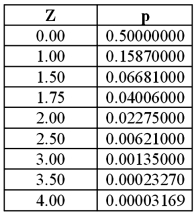Six Sigma is one approach for setting quality expectations for a given process or output. As pointed out in your text, the term "Six Sigma" comes from statistics: in a normal distribution, the area (probability) outside of +/- six standard deviations from the mean value is exceedingly small. You are provided the following values from a standardized normal distribution .
 Note: The Z values in the above table refer to the number of sigmas to the right of center . The listed probabilities, p, refer to the area to the right of the chosen Z point, as illustrated by the graph below:
Note: The Z values in the above table refer to the number of sigmas to the right of center . The listed probabilities, p, refer to the area to the right of the chosen Z point, as illustrated by the graph below:  Required:
Required:
1. Given the above, what is the probability for a 1-sigma performance level? How many defects might we expect for a process that is operating at 1-sigma level?
2. Redo #1 above, but this time for a 3-sigma level. What is the percentage increase in quality expected under a 3-sigma performance level compared to a 1-sigma level?
3. Redo #1 above, but this time for a 4-sigma level. Also, what is the anticipated percentage improvement in quality when moving from a 3-sigma to a 4-sigma performance level?
Definitions:
Q5: Performance evaluation in most firms is applied
Q18: The total sales mix variance for both
Q40: Which one of the following is not
Q59: A graph that depicts successive observations of
Q69: During January, Long, Inc. produced 10,000 units
Q79: What is the factory overhead efficiency variance
Q104: Paquindo Co. has two products: X and
Q123: Assume that the Entertainment Division is able
Q144: Intangible attributes often play dominant roles in
Q157: Under a three-way breakdown (decomposition) of the